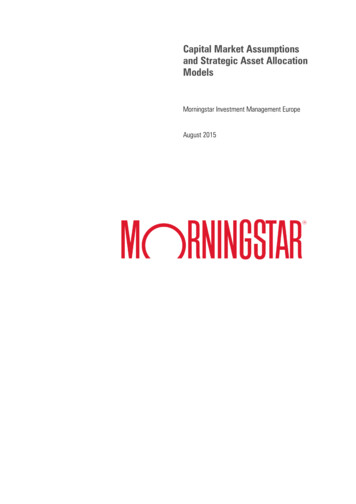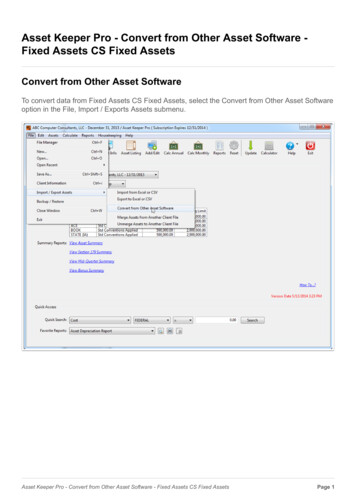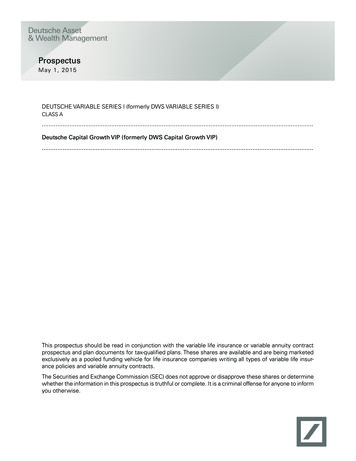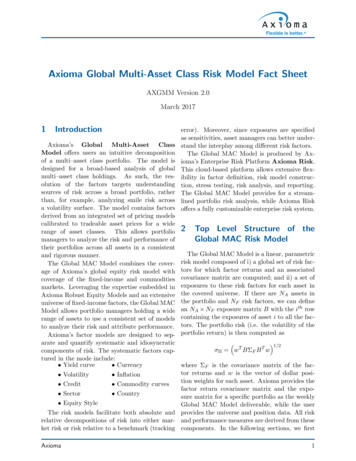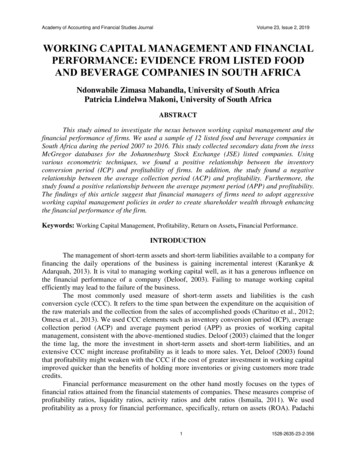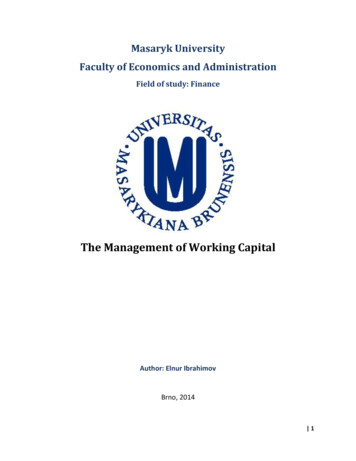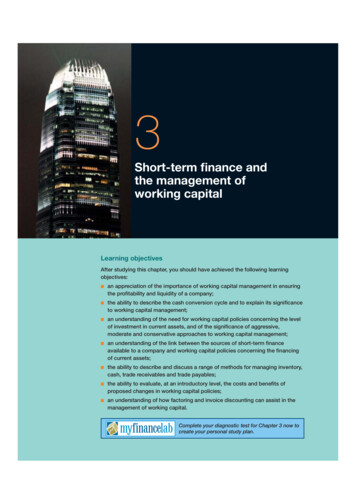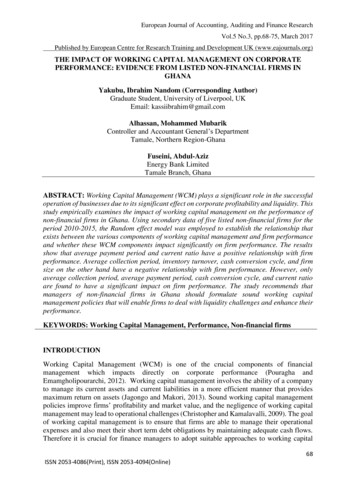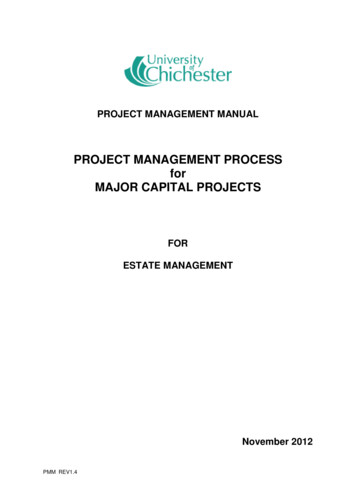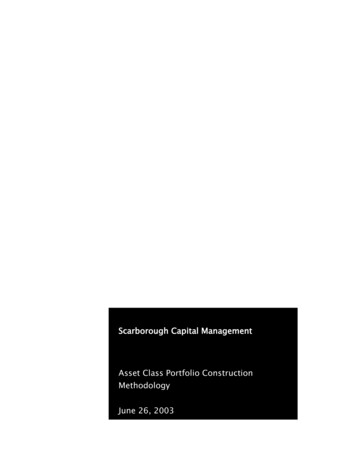
Transcription
Scarborough Capital ManagementAsset Class Portfolio ConstructionMethodologyJune 26, 2003
Asset Class PortfolioConstruction MethodologyPrepared forScarborough GroupJune 26, 2003225 North Michigan Avenue Suite 700 Chicago, IL 60601-7676 (312) 616-1620Prepared by:David Turney . Senior Analyst
Table of ContentsSection I – Executive Summary . 1Overview. 1Asset Class Level Portfolios . 2Table 1. Asset Class Level Portfolios . 2Section II – Construction of Asset Class Level Portfolios . 4Asset Classes and Benchmarks Defined . 4Table 2. Asset Classes and Benchmarks . 4Mean Variance Analysis and Inputs . 5Table 3. Risk-Free Rates. 7Input Construction Results . 13Table 4. Inputs Summary. 13Table 5. Expected Return Development . 14Table 6. Standard Deviation Development . 14Practical Considerations in Constructing Asset Class Level Portfolio Allocations . 17Probability Distributions: . 25Probability Distributions . 25Sensitivity Analysis . 28Section III - Appendices . 37Appendix A - Benchmark Explanations . 37Appendix B - Input Clarifications: Proxies . 41Appendix C - Statistical Methods . 43Appendix D - Correlation Coefficient Extension Process. 46Appendix E - Supply Side Equity Risk Premium Estimate . 53Appendix F - Forecasting the Inflation Rate . 57 2003 Ibbotson AssociatesTable of ContentsScarborough
Section I – Executive SummaryOverviewThis document outlines the development of asset allocation tools for Scarborough Group (Scarborough)to be used by retirement plan participants. The work product will be distributed via representatives ofScarborough Group and Scarborough Retirement Services. Ibbotson Associates (Ibbotson) developed oneset of model asset class portfolios. Ibbotson analyzed broad asset classes as the basis for the workpresented in this document. Ibbotson developed the following asset allocation tools:Asset Class Level Portfolios – Ibbotson provides portfolios which detail asset class allocation.The portfolios span the risk spectrum from conservative to aggressive.About Ibbotson AssociatesIbbotson Associates opened its doors in 1977 to bridge the gap between modern financial theory and realworld investment practice. Professor Roger G. Ibbotson, the company founder and Chairman, pioneeredcollecting the requisite data used in asset allocation and in quantifying the benefits of diversification. Thefirm continues to provide solutions to investment and finance problems for a diverse set of markets.Ibbotson Associates fills a growing need in the finance industry as a single-source provider of investmentknowledge, expertise, and technology.Ibbotson Associates’ investment management services include asset allocation design, back-testing ofportfolio strategies, mutual fund analysis, assessment of investor risk tolerance, employee training,structuring and education for retirement plans, and client-specific research. Ibbotson Associates’ productsinclude client presentation materials, computer-based training, and asset allocation software tools. 2003 Ibbotson AssociatesSection I – Executive SummaryPage 1Scarborough
Asset Class Level PortfoliosGeneral CommentsAt the outset of this engagement, Scarborough identified the asset classes to be used for portfolioconstruction. In formulating diversified portfolios, Ibbotson employed a statistical technique known asoptimization. The goal of optimization is to identify portfolios that maximize return for a given level ofrisk or minimize risk for a given level of return. Optimization requires forecasting returns, standarddeviations and correlation coefficients of asset classes over the desired investing horizon. Appropriateemployment of optimization as a tool also involves applying qualitative reasoning, including sensitivityanalysis, assessment of probability distributions and reconciliation with investor utility and sentiment.FindingsThe table below displays the asset class level portfolios developed for Scarborough by Ibbotson.Table 1. Asset Class Level PortfoliosAsset ClassPortfolios1234567Large Cap Growth Stocks36912141720Large Cap Value Stocks7121519212225Mid Cap Stocks2468101213Small Cap Growth Stocks0000345Small Cap Value Stocks0234457International Stocks481216212630High Yield Bonds6543000Intermediate Term Bonds161512101080Short Term Bonds372823201760Cash Equivalents2520168000Percent Equity163245597386100Percent Fixed Income8468554127140Expected Arithmetic Return5.26.47.38.39.210.111.1Expected Geometric Return5.16.26.97.78.38.99.5Standard Deviation4.97.29.411.914.316.719.3 2003 Ibbotson AssociatesSection I – Executive SummaryPage 2Scarborough
Report ReferencesIbbotson followed a number of steps in completing this project. Each step in the process corresponds to asection of this report. These sections are listed below:Section II: Construction of Asset Class Level PortfoliosAsset Classes and Benchmarks Defined: Identifies the specific asset classes and benchmarksconsidered in the project and discusses benchmark issues.Mean Variance Analysis and Inputs: Describes the methodology for forecasting the inputsused for optimization including: expected asset class returns, standard deviations andcorrelation coefficients.Practical Considerations in Constructing Asset Class Level Portfolio Allocations:Identifies practical methodologies applied in constructing portfolios, including portfolioconstraints, portfolio spacing and performance criteria.Section III: Appendices – Documentation and Explanation of Related Topics 2003 Ibbotson AssociatesSection I – Executive SummaryPage 3Scarborough
Section II – Construction of Asset Class Level PortfoliosAsset Classes and Benchmarks DefinedAsset classes are defined as categories of investments with common characteristics. Some of thecharacteristics typically used to separate investment securities into asset classes are:The nature of the financial claim (debt, equity)The security issuer (foreign/domestic, government/corporate)The term length of debt obligation (short, intermediate, long)Others (liquidity, risk)Ibbotson defines asset classes such that no one security can be classified into more than one category. Asa result, securities within well-defined asset classes should react similarly to changes in economiccircumstances.Asset classes are comprised of a large group of securities. An index is a theoretical portfolio, createdfrom a subset of securities in a specific asset class. Ibbotson uses indexes as benchmarks for theperformance of the asset classes as a whole. In some instances, the index consists of all the securitieswithin an asset class. Useful benchmarks are those which, represent the asset class, trade in establishedmarkets that provide price information (i.e., the New York Stock Exchange or the American StockExchange) and have publicly available price historiesAlthough there are several benchmarks available for each asset class, a set of benchmarks that best fit thecriteria outlined above were chosen. The relevant asset classes and benchmarks are displayed in thefollowing table:Table 2. Asset Classes and BenchmarksAsset ClassBenchmark1,2Large Cap Growth StocksLarge Cap Value StocksMid Cap StocksSmall Cap Growth StocksSmall Cap Value StocksInternational StocksHigh Yield BondsIntermediate Term BondsShort Term BondsCash EquivalentsS&P/BARRA 500 GrowthS&P/BARRA 500 ValueCRSP Deciles 3-5S&P/Barra Smallcap 600 GrowthS&P/Barra Smallcap 600 ValueMSCI EAFELB High YieldLB IT Gvt/CreditLB 1-3 Yr GvtCG U.S. Domestic 3 Mo Tbill1Ibbotson Associates also uses MSCI World Index, Ibbotson Associates Long-Term U.S. Government Bond Series, severalCRSP Deciles and CFI (Coleman, Fisher, and Ibbotson) Synthetic Bonds to aid in determining the inputs.2See Appendix A for a description of CRSP Deciles and CFI Bonds 2003 Ibbotson AssociatesSection II – Construction of Asset Class Level PortfoliosPage 4Scarborough
Mean Variance Analysis and InputsIntroduction: Required ForecastsThe methodology used by Ibbotson to determine investment portfolios is mean-variance analysis. Meanvariance analysis was developed by Harry Markowitz in the 1950’s and provides a mathematicalframework for generating portfolios that maximize expected return for a given level of risk (efficientportfolios), and can assist investors in making strategic asset allocation decisions.Mean variance analysis is most appropriate for relatively efficient markets. Ibbotson assumes that assetmarkets are informationally efficient, with all relevant and available information fully incorporated inasset prices. If markets are informationally efficient, investor expectations (forecasts) can be discernedfrom market-observable data. The forecasts made by Ibbotson are not attempts to predict the market,rather attempts to ascertain the market’s expectations, i.e., to determine what the market itself isforecasting.Mean-variance analysis requires three statistical estimates for each asset class:1. Expected return (Mean)2. Expected risk (Standard Deviation)3. Expected relationship between the asset classes (Correlation Coefficients)Ibbotson develops forecasts for each of these statistics using a combination of historical data, currentmarket information, and additional analysis. Each forecast becomes an input in mean-variance analysis.Historical data incorporate a number of economic events and are therefore helpful to develop forecasts.Pure historical analysis, however, can be misleading. Historical data reflect the economic and marketevents that occurred in a specific time period. Therefore, data that do not contain the same events do notprovide useful comparisons. This is problematic when the benchmarks of different asset classes havedifferent periods of historical data available.Ibbotson makes two important adjustments in order to properly include historical data into the forecastingprocess:1. Determine the relevant time period – Relevant data present a good estimate of futuremarket conditions and include outcomes that can reasonably be expected to reoccur.2. Adjust short-lived data – Ibbotson estimates what might have happened had an asset classbenchmark existed in prior periods. Adjustments ensure that estimates incorporate outcomesthat occurred over the full, relevant time period.In some cases evidence may exist that suggests a fundamental change in market structure, therebylimiting the efficacy of certain historical periods. Ibbotson maintains that all data from 1926 is relevantfor equity asset classes. The fixed income market, however, underwent a structural change during the1970’s that makes data prior to 1970 irrelevant. During the 1970’s the Bretton Woods Agreement, whichfixed exchange rates, fell apart. The money supply was difficult to manage and the Federal Reserve wasenticed to shift policy from managing interest rates to managing the money supply. These structuralchanges make the interest rate environment since 1970 inherently different from previous periods. 2003 Ibbotson AssociatesSection II – Construction of Asset Class Level PortfoliosPage 5Scarborough
The following chart demonstrates how these changes have altered the risk and return characteristics offixed income investments.Long-Term U.S. Treasury Bonds* His
presented in this document. Ibbotson developed the following asset allocation tools: Asset Class Level Portfolios – Ibbotson provides portfolios which detail asset class allocation. The portfolios span the risk spectrum from conservative to aggressive. About Ibbotson Associates Ibbotson Associates opened its doors in 1977 to bridge the gap between modern financial theory and real

